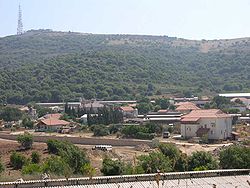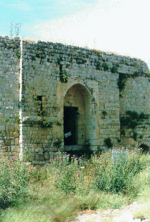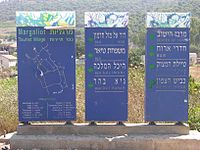- Margaliot
-
Margaliot 
View of MargaliotFounded 1951 Founded by Jewish immigrants from Yemen and Iraq. Council Mevo'ot HaHermon Regional Council Region Upper Galilee District North Coordinates 33°12′52″N 35°32′41″E / 33.21444°N 35.54472°ECoordinates: 33°12′52″N 35°32′41″E / 33.21444°N 35.54472°E Population 427 (2009) Margaliot (Hebrew: מַרְגָּלִיּוֹת; Arabic: هونين) is a moshav in the Upper Galilee in northern Israel, located along the border with Lebanon, near the town of Kiryat Shmona. It is part of the Mevo'ot HaHermon Regional Council. The settlement is home to approximately 400 residents, most of them Jews of Iranian Kurdistan descent.
Contents
History
Hunin Arabic District Safad Coordinates 33°12′52″N 35°32′41″E / 33.21444°N 35.54472°ECoordinates: 33°12′52″N 35°32′41″E / 33.21444°N 35.54472°E Population (1948) Area Date of depopulation 3 May 1948/September 1948[1] Cause(s) of depopulation Fear of being caught up in the fighting Secondary cause Expulsion by Yishuv forces Margaliot was established in 1951 on the site of the Lebanese town of Hunin, which is part of the Seven Lebanese Villages across the Lebanese/Israeli border, by Jewish immigrants from Yemen and Iraq. The moshav was renamed after Chaim Margaliot Kalverisky, who headed the Jewish Colonization Association in the Galilee in the early twentieth century, and participated in the establishment of several Jewish settlements in the area. Today, neighboring Arab states (especially Lebanon), use the name Hunin to refer to the area covering moshav Margaliot and kibbutz Misgav Am.
Château Neuf (New Castle), a Crusader fortress, is situated by the road leading to the moshav. Château Neuf provides a clear view of the Nimrod Fortress and several other fortresses in the area.[which?] The Syria-Lebanon-Palestine boundary was a product of the post-World War I Anglo-French partition of Ottoman Syria.[2][3] British forces had advanced to a position at Tel Hazor against Turkish troops in 1918 and wished to incorporate all the sources of the Jordan River within British controlled Palestine. Following the Paris Peace Conference of 1919, and the unratified and later annulled Treaty of Sèvres, stemming from the San Remo conference, the 1920 boundary extended the British controlled area to north of the Sykes Picot line, a straight line between the mid point of the Sea of Galilee and Nahariya. The international boundary between Palestine and Lebanon was finally agreed upon by Great Britain and France in 1923, in conjunction with the Treaty of Lausanne, after Britain had been given a League of Nations mandate for Palestine in 1922.[4]
In April 1924, Hunin, along with seven other villages, and an estimated 20 other settlements, were transferred from the French Mandate of Lebanon to the British mandate of Palestine by France. Margaliot (Hunin) was claimed by Britain's Zionist allies; while, after the independence of Lebanon, the new Lebanese government asked for the return of this village and the rest of the villages and settlements. As of today, the Lebanese government still demands the return of these lands.[5][6]
Events of 1948
Hunin was a Shi'ite Muslim village with a population of 1620 recorded in 1945.[7] A Palmach raid in May 1948 led to many of the inhabitants fleeing to Lebanon, leaving 400 remaining in the village. During a meeting in August 1948, when only 400 villagers remained in Hunin, the mukhtars of Hunin and some other Shi'ite villages met with the Jews of kibbutz Kfar Giladi to try to make a peace agreement with the state of Israel. They promised to live as loyal citizens (minority under Jewish rule) and renounce Arab national aspirations. With the support of the local Jews, a report was made by the Department of Minorities recommending that such an agreement be reached with the 4,700 or so Shi'ites in the region to promote friendly relations with southern Lebanon, to take advantage of the Shi'ites' poor relationship with the majority Sunnis, and to enhance the prospect of a future extension of the border.[7] This proposal was not accepted, despite the support of the minorities minister Bekhor Shitreet.[7]
In August, more inhabitants of Hunin were forced to flee by the IDF.[8] On September the 3rd 1948, the IDF raided the village blowing up 20 houses, killing a son of the mukhtar and 19 others and expelling the remaining villagers.[8]
See also
- List of Arab towns and villages depopulated during the 1948 Arab-Israeli War
- Metawali
- Seven Lebanese Villages
References
- ^ Morris, 2004, p. xvi village #6. Also gives causes of depopulation.
- ^ David Fromkin (1989). A peace to end all peace: the fall of the Ottoman Empire and the creation of the modern Middle East. Macmillan. ISBN 978-0-8050-8809-0.
- ^ Margaret MacMillan (2001). Peacemakers: the Paris Conference of 1919 and its attempt to end war. John Murray. pp. 392–420. ISBN 978-0-7195-6237-2.
- ^ Exchange of Notes Constituting an Agreement respecting the boundary line between Syria and Palestine from the Mediterranean to El Hammé. Paris, March 7, 1923.
- ^ "Lebanon to restore seven villages annexed by the French mandate to Palestine". Arabicnews.com. December 23, 1999. http://www.arabicnews.com/ansub/Daily/Day/991223/1999122311.html. Retrieved 2011-09-19.
- ^ "A Lebanese border town removed by Israel to be rebuilt by its citizens". Arabicnews.com. May 25, 2001. http://www.arabicnews.com/ansub/Daily/Day/010525/2001052504.html. Retrieved 2011-09-19.
- ^ a b c Sindawi, Khalid (2008). Are there any Shi'te Muslims in Israel?", Holy Land Studies, Vol. 7, No. 2, 183-199.
- ^ a b Morris, 2004, p. 249
Bibliography
- Hadawi, Sami (1970), Village Statistics of 1945: A Classification of Land and Area ownership in Palestine, Palestine Liberation Organization Research Center, http://www.palestineremembered.com/Articles/General-2/Story3150.html
- Khalidi, Walid (1992), All That Remains: The Palestinian Villages Occupied and Depopulated by Israel in 1948, Washington D.C.: Institute for Palestine Studies, ISBN 0887282245
- Morris, Benny (2004). The Birth of the Palestinian Refugee Problem Revisited. Cambridge University Press. ISBN 9780521009676. http://books.google.com/?id=uM_kFX6edX8C&printsec=frontcover&dq=benny+morris&q.
External links
- Welcome to Hunin
- Hunin, at Khalil Sakakini Cultural Center
- Hunin, by Dr. Khalil Rizk.
Moshavim Amnun · Beit Hillel · Dishon · Elifelet · Kahal · Margaliot · Mishmar HaYarden · Ramot Naftali · Sde Eliezer · She'ar Yashuv · YuvalCommunal settlements Arab towns and villages depopulated during the 1948 Palestine War Acre al-Amqa · Arab al-Samniyya · al-Bassa · al-Birwa · al-Damun · Dayr al-Qassi · al-Ghabisiyya · Iqrit · Iribbin · Jiddin · al-Kabri · Kafr 'Inan · Kuwaykat · al-Manshiyya · al-Mansura · Mi'ar · al-Nabi Rubin · al-Nahr · al-Ruways · Suhmata · al-Sumayriyya · Suruh · al-Tall · Tarbikha · Umm al-Faraj · al-Zeeb
Baysan Arab al-'Arida · Arab al-Bawati · Arab al-Safa · al-Ashrafiyya · al-Bira · Beisan · Danna · Farwana · al-Fatur · al-Ghazzawiyya · al-Hamidiyya · al-Hamra · Jabbul · Kafra · Kawkab al-Hawa · al-Khunayzir · Masil al-Jizl · al-Murassas · Qumya · al-Sakhina · al-Samiriyya · Sirin · Tall al-Shawk · al-Taqa · al-Tira · Umm 'Ajra · Umm Sabuna, Khirbat · Yubla · Zab'a · al-Zawiya
Beersheba Gaza Arab Suqrir · Barbara · Barqa · al-Batani al-Gharbi · al-Batani al-Sharqi · Bayt 'Affa · Bayt Daras · Bayt Jirja · Bayt Tima · Bil'in · Burayr · Dayr Sunayd · Dimra · al-Faluja · Hamama · Hatta · Hiribya · Huj · Hulayqat · Ibdis · Iraq al-Manshiyya · Iraq Suwaydan · Isdud · al-Jaladiyya · al-Jiyya · Julis · al-Jura · Jusayr · Karatiyya · Kawfakha · Kawkaba · al-Khisas · al-Masmiyya al-Kabira · al-Masmiyya al-Saghira · al-Muharraqa · Najd · Ni'ilya · Qastina · al-Sawafir al-Gharbiyya · al-Sawafir al-Shamaliyya · al-Sawafir al-Sharqiyya · Simsim · Summil · Tall al-Turmus · Yasur
Haifa Abu Shusha · Abu Zurayq · Arab al-Fuqara · Arab al-Nufay'at · Arab Zahrat al-Dumayri · 'Atlit · Ayn Ghazal · Ayn Hawd · Balad ash-Sheikh · Barrat Qisarya · Burayka · al-Burj · al-Butaymat · Daliyat al-Rawha' · al-Dumun · al-Ghubayya al-Fawqa · al-Ghubayya al-Tahta · Hawsha · Ijzim · Jaba' · al Jalama · Kabara · al-Kafrayn · Kafr Lam · al-Kasayir · Khubbayza · Lid · al-Manara · al-Mansi · al-Mansura · al-Mazar · Naghnaghiya · Qamun · Qannir · Qira · Qisarya · Qumbaza · al-Rihaniyya · Sabbarin · al-Sarafand · Khirbat al-Sarkas · Khirbat Sa'sa' · al-Sawamir · Khirbat al-Shuna · al-Sindiyana · al-Tantura · al-Tira · Umm al-Shawf · Umm al-Zinat · Wa'arat al-Sarris · Wadi Ara · Yajur
Hebron 'Ajjur · Barqusya · Bayt Jibrin · Bayt Nattif · al-Dawayima · Deir al-Dubban · Dayr Nakhkhas · Kudna · Mughallis · al-Qubayba · Ra'na · Tell es-Safi · Umm Burj · az-Zakariyya · Zayta · Zikrin
Jaffa al-'Abbasiyya · Abu Kabir · Abu Kishk · Bayt Dajan · Biyar 'Adas · Fajja · al-Haram · Ijlil al-Qibliyya · Ijlil al-Shamaliyya · al-Jammasin al-Gharbi · al-Jammasin al-Sharqi · Jarisha · Kafr 'Ana · al-Khayriyya · al-Mas'udiyya · al-Mirr · al-Muwaylih · Rantiya · al-Safiriyya · Salama · Saqiya · al-Sawalima · al-Shaykh Muwannis · Yazur
Jerusalem Allar · Aqqur · Artuf · Bayt 'Itab · Bayt Mahsir · Bayt Naqquba · Bayt Thul · Bayt Umm al-Mays · al-Burayj · Dayr Aban · Dayr 'Amr · Dayr al-Hawa · Dayr Rafat · Dayr al-Shaykh · Deir Yassin · Ayn Karim · Ishwa · Islin · Ism Allah · Jarash · al-Jura · Kasla · al-Lawz · Lifta · al-Maliha · Nitaf · al-Qabu · Qalunya · al-Qastal · Ras Abu 'Ammar · Sar'a · Saris · Sataf · Sheikh Badr · Suba · Sufla · al-Tannur · al-'Umur · al-Walaja
Jenin Nazareth Indur · Ma'alul · al-Mujaydil · Saffuriyya
Ramla Abu al-Fadl · Abu Shusha · Ajanjul · Aqir · Barfiliya · al-Barriyya · Bashshit · Bayt Far · Bayt Jiz · Bayt Nabala · Bayt Shanna · Bayt Susin · Bir Ma'in · Bir Salim · al-Burj · al-Buwayra · Daniyal · Dayr Abu Salama · Dayr Ayyub · Dayr Muhaysin · Dayr Tarif · al-Duhayriyya · al-Haditha · Idnibba · Innaba · Jilya · Jimzu · Kharruba · al-Khayma · Khulda · al-Kunayyisa · al-Latrun · Lydda · al-Maghar · Majdal Yaba · al-Mansura · al-Mukhayzin · al-Muzayri'a · al-Na'ani · an-Nabi Rubin · Qatra · Qazaza · al-Qubab · al-Qubayba · Qula · Ramla · Sajad · Salbit · Sarafand al-Amar · Sarafand al-Kharab · Saydun · Shahma · Shilta · al-Tina · al-Tira · Umm Kalkha · Wadi Hunayn · Yibna · Zakariyya · Zarnuqa
Safad Abil al-Qamh · al-'Abisiyya · 'Akbara · Alma · Ammuqa · Arab al-Shamalina · Arab al-Zubayd · Ayn al-Zaytun · Baysamun · Biriyya · al-Butayha · al-Buwayziyya · Dallata · al-Dawwara · Dayshum · al-Dirbashiyya · al-Dirdara · Fara · al-Farradiyya · Fir'im · Ghabbatiyya · Ghuraba · al-Hamra' · Harrawi · Hunin · al-Husayniyya · Jahula · al-Ja'una · Jubb Yusuf · Kafr Bir'im · al-Khalisa · Khan al-Duwayr · Karraza, Khirbat · al-Khisas · Khiyam al-Walid · Kirad al-Baqqara · Kirad al-Ghannama · Lazzaza · Madahil · Al-Malkiyya · Mallaha · al-Manshiyya · al-Mansura · Mansurat al-Khayt · Marus · Meiron · al-Muftakhira · Mughr al-Khayt · al-Muntar · al-Nabi Yusha' · al-Na'ima · Qabba'a · Qadas · Qaddita · Qaytiyya · al-Qudayriyya · al-Ras al-Ahmar · Sabalan · Safsaf · Saliha · al-Salihiyya · al-Sammu'i · al-Sanbariyya · Sa'sa' · al-Shawka al-Tahta · al-Shuna · Taytaba · Tulayl · al-'Ulmaniyya · al-'Urayfiyya · al-Wayziyya · Yarda, Safad · al-Zahiriyya al-Tahta · al-Zanghariyya · al-Zawiya · al-Zuq al-Fawqani · al-Zuq al-Tahtani
Tiberias Awlam · al-Dalhamiyya · Ghuwayr Abu Shusha · Hadatha · al-Hamma · Hittin · Kafr Sabt · Lubya · Ma'dhar · al-Majdal · al-Manara · al-Manshiyya · al-Mansura · Nasir al-Din · Nimrin · al-Nuqayb · Samakh · al-Samakiyya · al-Samra · al-Shajara · al-Tabigha · al-'Ubaydiyya · al-Wa'ra al-Sawda', Khirbat · Yaquq
Tulkarm Khirbat Bayt Lid · Bayyarat Hannun · Fardisya · Ghabat Kafr Sur · al Jalama · Kafr Saba · al-Majdal · al-Manshiyya · Miska · Qaqun · Raml Zayta · Tabsur · Umm Khalid · Wadi al-Hawarith · Wadi Qabbani · al-Zabadida · Khirbat Zalafa
Crusader sites in Israel State of Israel Abu Ghosh • Achziv • Acre • Arsuf • Ashkelon • Ateret Fortress • Azor • Bayt 'Itab • Beit Guvrin • Beit She'an • Belvoir • Burgata • Caesarea • Cafarlet • Château Pèlerin • Destroit • Givat Titora • Ein Hemed • Jerusalem • Khirbat Rushmiya • Margaliot • Mi'ilya • Migdal Afek • Montfort • Qalansawe • Qaqun • Qastal • Qula • Safed • Taibe • Tel Afek • Tel Hanaton • Tel Tzafit • Tel Tzova • Tel Yavne • Tiberias • Tzippori • Umm Khalid • Yehiam
Categories:- Mevo'ot HaHermon Regional Council
- Moshavim
- District of Safad
- Populated places in the South Governorate
- North District (Israel)
- Geography of Israel
- Geography of Lebanon
- Israeli–Lebanese conflict
- Territorial disputes of Israel
- Territorial disputes of Lebanon
- Israel–Lebanon border
Wikimedia Foundation. 2010.



